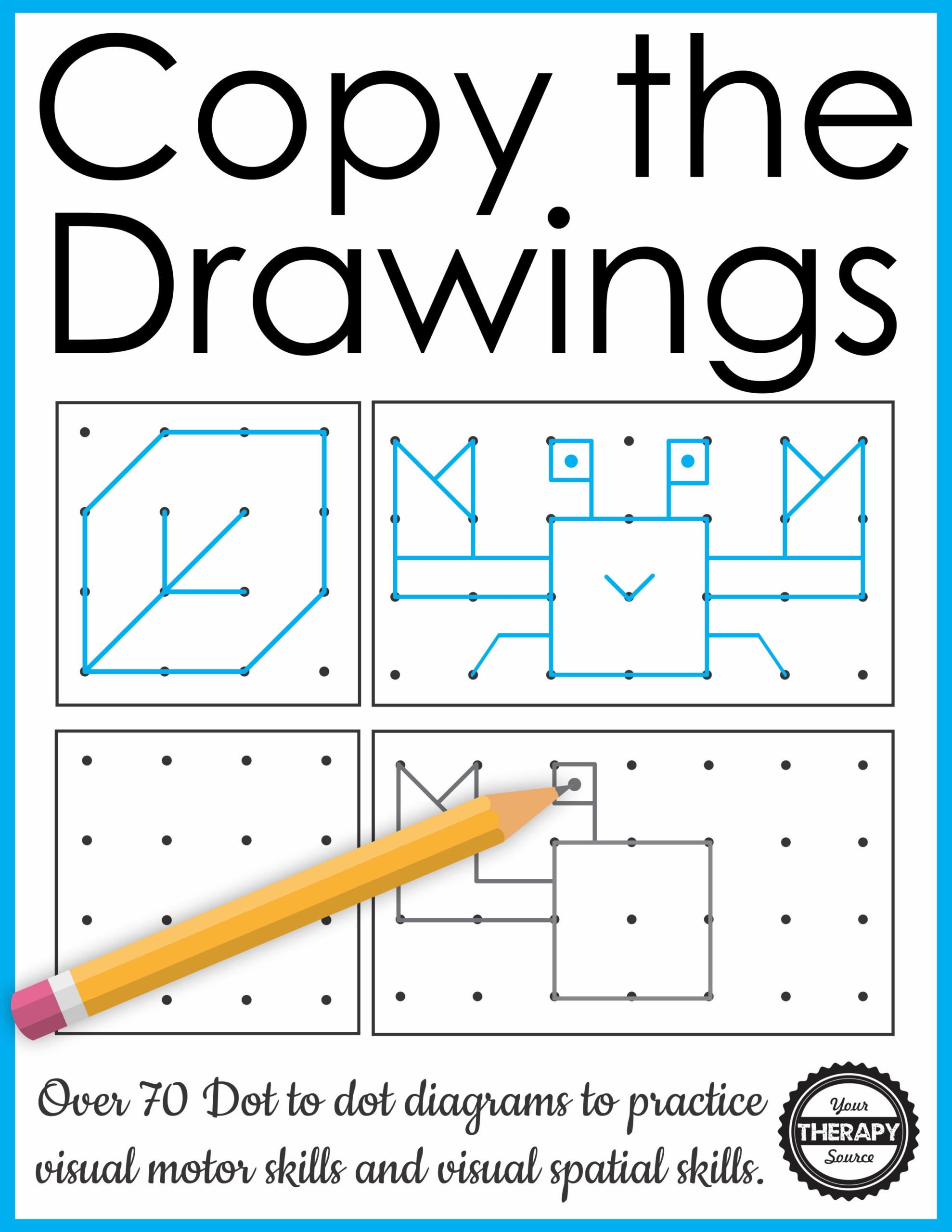Visual Motor Integration and Academics – What Does the Research Say?

Visuomotor Integration (VMI) is the coordination between what we see and how we move. It’s a skill that involves understanding visual information and using it to guide physical actions. This is crucial for everyday tasks like eating with utensils or tying shoelaces, and it’s also fundamental in academic skills such as counting with fingers or handwriting. Read more about what the research says about visual motor integration and academics.
Why is VMI Important in Education?
VMI plays a significant role in a child’s academic success, beyond their IQ and executive functions. It’s closely linked to school readiness and can be a predictor of overall academic achievement. VMI skills, like following instructions, concentrating on tasks, and handling writing tools, overlap with the skills needed for success in school.

Spatial Awareness Puzzles – Copy the Drawings
Assessing VMI
How Do We Measure VMI?
VMI is typically assessed through tasks like copying drawings, which help gauge the integration of visual processing and motor coordination. Common assessment tools include the Beery Developmental Test of Visual-Motor Integration and the Bender Gestalt Test. These tests measure how well a child can replicate complex figures, offering insights into their VMI abilities.
VMI’s Role in Mathematics and Reading
VMI and Math Achievement
VMI is linked to math skills from an early age. For example, using fingers to count or solve arithmetic problems is a form of VMI. Studies have shown that hands-on learning with manipulatives like blocks can enhance math understanding, indicating a strong connection between VMI and math achievement.
VMI and Reading Skills
While the link between VMI and reading is less clear than with math, there are still significant correlations. VMI may influence reading through its impact on handwriting, as handwriting requires attention to letter forms, which aids in letter and word recognition. This connection is particularly evident in young learners.
VMI, Intelligence, and Academic Success
Beyond IQ: VMI’s Unique Contribution
While intelligence is a known predictor of academic achievement, studies suggest that VMI offers a unique contribution to learning outcomes. It’s been found that VMI can predict math achievement independently of IQ. However, the relationship between VMI and reading achievement is less clear once IQ is accounted for.

Pre-Writing Strokes
Recent Research on Visual Motor Integration and Academics
This recent study expanded on previous research showing that Visuomotor Integration (VMI) is linked to academic achievement. Using a multilevel meta-analysis, the study explored:
- how VMI relates to different academic areas, such as reading and mathematics, and their specific subdomains.
- whether the impact of VMI on academic success varies across different educational stages: early childhood, elementary, and secondary education.
- VMI’s relationship with academic outcomes may change based on the educational stage and in students with various disabilities.
- domain-general cognitive abilities, such as IQ, as potential confounding factors.
This study was the first meta-analysis to systematically assess the relationship between VMI and academic achievement across different educational stages and considering factors like IQ and disabilities. The findings aim to underscore the importance of assessing VMI early in a child’s education and to identify groups who would benefit the most from VMI-focused interventions.
Results of the Study on Visual Motor Integration and Academics
Understanding VMI’s Role in Academic Performance
- VMI in Mathematics and Reading: The study shows a moderate correlation between VMI and both math (r = 0.39) and reading (r = 0.34) achievements. These connections are consistent across all ages but are stronger in younger students, especially for reading.
- VMI’s Impact Varies by Age: Younger students show a stronger link between VMI and academic success. This is likely because VMI is more involved in early learning strategies, like using fingers for counting or learning to write letters, which are crucial for developing basic math and reading skills.
VMI’s Relation to Cognitive Abilities and Disabilities
- Stronger in Early Learning: VMI seems particularly relevant in early educational stages like preschool and Kindergarten, where it’s closely tied to learning fundamental math and reading skills.
- Higher Correlation with Disabilities and Lower IQ: Students with mental disabilities or lower IQs show a stronger relationship between VMI and math achievement. This suggests VMI’s role might be more prominent in students facing certain learning challenges.

Prewriting and Scissor Skills 12 Month Bundle
VMI as a Predictor of School Readiness
- Indicator of Early Academic Skills: VMI is a useful measure for predicting school readiness, especially in young learners and those with below-average IQs.
- Not Necessarily Causal: The correlations between VMI and academic performance don’t imply a direct cause-and-effect relationship. They might both stem from underlying factors like executive functions.
Future Research Directions
- Exploring VMI in Older Students: There’s a need to understand VMI’s continued influence in secondary education, especially in relation to advanced math skills.
- Interventions to Improve VMI: Research should also focus on effective interventions to enhance VMI, particularly in early learning and for students with special education needs.
Key Takeaways for Educators and Therapists
- Early Identification and Support: Recognizing and supporting VMI is important for predicting and enhancing academic readiness, particularly in young children.
- Tailored Educational Strategies: Understanding VMI’s varying impact on students with different cognitive abilities and disabilities can guide more effective teaching and therapeutic approaches.
Overall Implications of Visual Motor Integration and Academics
The study highlights the significant role of VMI in both mathematics and reading achievement across different educational stages. It also underscores the varying impact of VMI based on disability types and educational stages, providing valuable insights for tailored educational interventions. The study also underlines the significant role of VMI in a child’s educational journey. For educators and occupational therapists, this means paying attention to VMI not just as a motor skill but as a key factor influencing academic development, especially in young learners and those with specific disabilities.
Reference
Khatib, L., Li, Y., Geary, D., & Popov, V. (2022). Meta-analysis on the relation between visuomotor integration and academic achievement: Role of educational stage and disability. Educational Research Review, 35, 100412.



